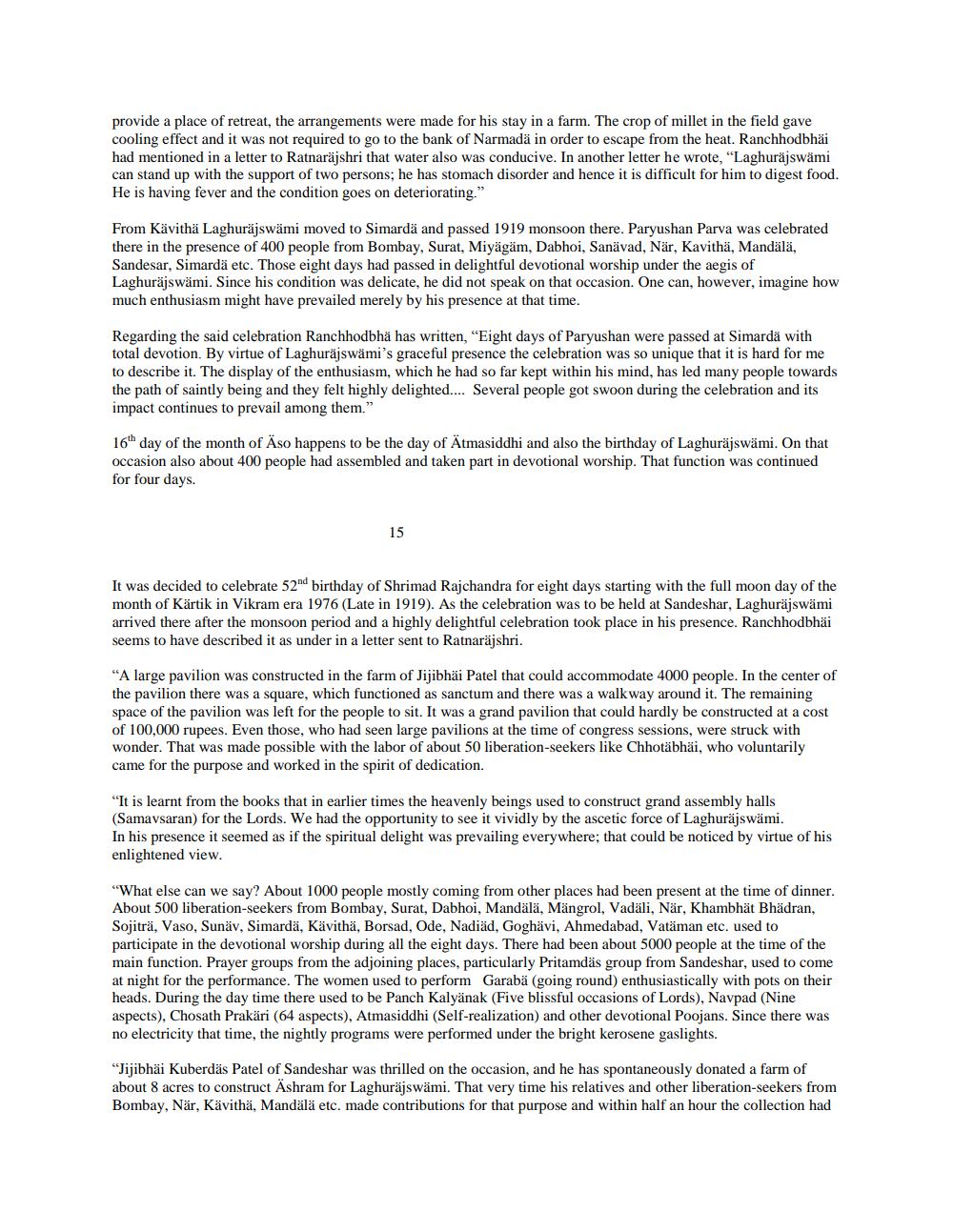________________
provide a place of retreat, the arrangements were made for his stay in a farm. The crop of millet in the field gave cooling effect and it was not required to go to the bank of Narmadä in order to escape from the heat. Ranchhodbhäi had mentioned in a letter to Ratnaräjshri that water also was conducive. In another letter he wrote, "Laghuräjswämi can stand up with the support of two persons; he has stomach disorder and hence it is difficult for him to digest food. He is having fever and the condition goes on deteriorating."
From Kävithä Laghuräjswämi moved to Simardä and passed 1919 monsoon there. Paryushan Parva was celebrated there in the presence of 400 people from Bombay, Surat, Miyagäm, Dabhoi, Sanävad, Når, Kavitha, Mandälä, Sandesar, Simardä etc. Those eight days had passed in delightful devotional worship under the aegis of Laghuräjswämi. Since his condition was delicate, he did not speak on that occasion. One can, however, imagine how much enthusiasm might have prevailed merely by his presence at that time.
Regarding the said celebration Ranchhodbhä has written, "Eight days of Paryushan were passed at Simardä with total devotion. By virtue of Laghuräjswämi's graceful presence the celebration was so unique that it is hard for me to describe it. The display of the enthusiasm, which he had so far kept within his mind, has led many people towards the path of saintly being and they felt highly delighted.... Several people got swoon during the celebration and its impact continues to prevail among them."
16th day of the month of Aso happens to be the day of Ätmasiddhi and also the birthday of Laghuräjswämi. On that occasion also about 400 people had assembled and taken part in devotional worship. That function was continued for four days.
It was decided to celebrate 52nd birthday of Shrimad Rajchandra for eight days starting with the full moon day of the month of Kärtik in Vikram era 1976 (Late in 1919). As the celebration was to be held at Sandeshar, Laghuräjswämi arrived there after the monsoon period and a highly delightful celebration took place in his presence. Ranchhodbhäi seems to have described it as under in a letter sent to Ratnarajshri.
"A large pavilion was constructed in the farm of Jijibhai Patel that could accommodate 4000 people. In the center of the pavilion there was a square, which functioned as sanctum and there was a walk way around it. The remaining space of the pavilion was left for the people to sit. It was a grand pavilion that could hardly be constructed at a cost of 100,000 rupees. Even those, who had seen large pavilions at the time of congress sessions, were struck with wonder. That was made possible with the labor of about 50 liberation-seekers like Chhotäbhäi, who voluntarily came for the purpose and worked in the spirit of dedication.
"It is learnt from the books that in earlier times the heavenly beings used to construct grand assembly halls (Samavsaran) for the Lords. We had the opportunity to see it vividly by the ascetic force of Laghuräjswämi. In his presence it seemed as if the spiritual delight was prevailing everywhere; that could be noticed by virtue of his enlightened view.
"What else can we say? About 1000 people mostly coming from other places had been present at the time of dinner. About 500 liberation-seekers from Bombay, Surat, Dabhoi, Mandälä, Mängrol, Vadäli, När, Khambhät Bhädran, Sojiträ, Vaso, Sunäv, Simardä, Kävitha, Borsad, Ode, Nadiad, Goghävi, Ahmedabad, Vataman etc. used to participate in the devotional worship during all the eight days. There had been about 5000 people at the time of the main function. Prayer groups from the adjoining places, particularly Pritamdäs group from Sandeshar, used to come at night for the performance. The women used to perform Garabä (going round) enthusiastically with pots on their heads. During the day time there used to be Panch Kalyänak (Five blissful occasions of Lords), Navpad (Nine aspects), Chosath Prakäri (64 aspects), Atmasiddhi (Self-realization) and other devotional Poojans. Since there was no electricity that time, the nightly programs were performed under the bright kerosene gaslights.
"Jijibhäi Kuberdas Patel of Sandeshar was thrilled on the occasion, and he has spontaneously donated a farm of about 8 acres to construct Ashram for Laghuräjswämi. That very time his relatives and other liberation-seekers from Bombay, När, Kävithä, Mandälä etc. made contributions for that purpose and within half an hour the collection had




